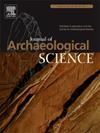Millet dominance and rice resilience at the Shang's eastern frontier: Climate, cultural interaction, and agricultural adaptation (1300–1046 BCE)
IF 2.6
1区 地球科学
Q1 ANTHROPOLOGY
引用次数: 0
Abstract
The Haidai region, renowned for its Neolithic cultural fluorescence (Dawenkou-Longshan traditions), underwent sociopolitical reorganization during the Yueshi period (ca. 1900–1500 BCE). Late Shang (1300–1046 BCE) expansion into Northern Shandong, driven by the Shang polity's control over Laizhou Bay salt resources, catalyzed regional revitalization, yet the agricultural foundations of this transformation remain poorly defined. Through AMS 14C dating, systematic analysis of carbonized plant remains from the Chengxixincun site, and synthesis of regional archaeobotanical datasets, we reconstruct Late Shang agricultural practices in Northern Shandong. Results of the site reveal a foxtail millet (Setaria italica)-dominated dryland system (93.24 % by count; 92.78 % ubiquity), supplemented by broomcorn millet (Panicum miliaceum, 6.12 %), with wheat (Triticum aestivum), soybean (Glycine max), and rice (Oryza sativa) as marginal crops. Weed and fruit remains attest to complementary wild resource exploitation. Comparative analysis demonstrates that Northern Shandong transitioned from Longshan-era rice-millet systems to intensified millet agriculture during Yueshi-period aridification (impact of the 4.2 ka BP event), later amplifying foxtail millet's dominance under Late Shang climatic amelioration and Central Plains agrotechnical diffusion. Crucially, rice cultivation—though never recovering Longshan-era prominence—persisted regionally (1.40 %), contrasting sharply with its near absence in contemporaneous Central Plains sites (0.03 %). This trajectory underscores the resilience of regional agricultural traditions amid climatic fluctuations and their negotiated adaptation to Shang cultural expansion, as ecological constraints and imperial resource demands shaped divergent agricultural pathways. By bridging archaeobotanical data with climatic and cultural proxies, this study establishes the first empirical model of agricultural adaptation in Shang frontier zones, redefining understandings of subsistence resilience and resource politics in early territorial states.
商朝东部边疆谷子优势和水稻韧性:气候、文化互动和农业适应(公元前1300-1046年)
以新石器文化(大汶口-龙山传统)闻名的海带地区,在月氏时期(约公元前1900-1500年)经历了社会政治重组。商朝晚期(公元前1300-1046年)在商朝对莱州湾盐资源控制的推动下,向山东北部扩张,促进了区域振兴,但这一转变的农业基础仍不明确。通过AMS 14C测年、程西新村遗址植物化石的系统分析和区域考古植物资料的综合,我们重建了鲁北地区商代晚期的农业活动。结果表明:旱地以谷子(Setaria italica)为主,占总数的93.24%;(92.78%),辅以黍(Panicum miliaceum, 6.12%),以小麦(Triticum aestivum)、大豆(Glycine max)和水稻(Oryza sativa)为边缘作物。杂草和水果遗迹证明了对野生资源的互补开发。对比分析表明,鲁北地区在月氏干旱化时期(4.2 ka BP事件的影响)由龙山时代的水稻-谷子系统过渡到集约化的谷子农业,在商代后期气候改善和中原农业技术扩散的影响下,谷子的优势地位进一步增强。至关重要的是,水稻种植——尽管从未恢复龙山时代的突出地位——在区域上持续存在(1.40%),与同期中原遗址几乎没有水稻种植(0.03%)形成鲜明对比。这一轨迹强调了区域农业传统在气候波动中的弹性,以及它们对商朝文化扩张的协商适应,因为生态限制和帝国资源需求塑造了不同的农业路径。通过将考古学数据与气候和文化指标相结合,本研究建立了商朝边疆地区农业适应性的第一个实证模型,重新定义了对早期领土国家的生存弹性和资源政治的理解。
本文章由计算机程序翻译,如有差异,请以英文原文为准。
求助全文
约1分钟内获得全文
求助全文
来源期刊

Journal of Archaeological Science
地学-地球科学综合
CiteScore
6.10
自引率
7.10%
发文量
112
审稿时长
49 days
期刊介绍:
The Journal of Archaeological Science is aimed at archaeologists and scientists with particular interests in advancing the development and application of scientific techniques and methodologies to all areas of archaeology. This established monthly journal publishes focus articles, original research papers and major review articles, of wide archaeological significance. The journal provides an international forum for archaeologists and scientists from widely different scientific backgrounds who share a common interest in developing and applying scientific methods to inform major debates through improving the quality and reliability of scientific information derived from archaeological research.
 求助内容:
求助内容: 应助结果提醒方式:
应助结果提醒方式:


